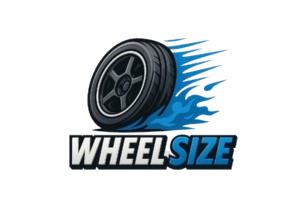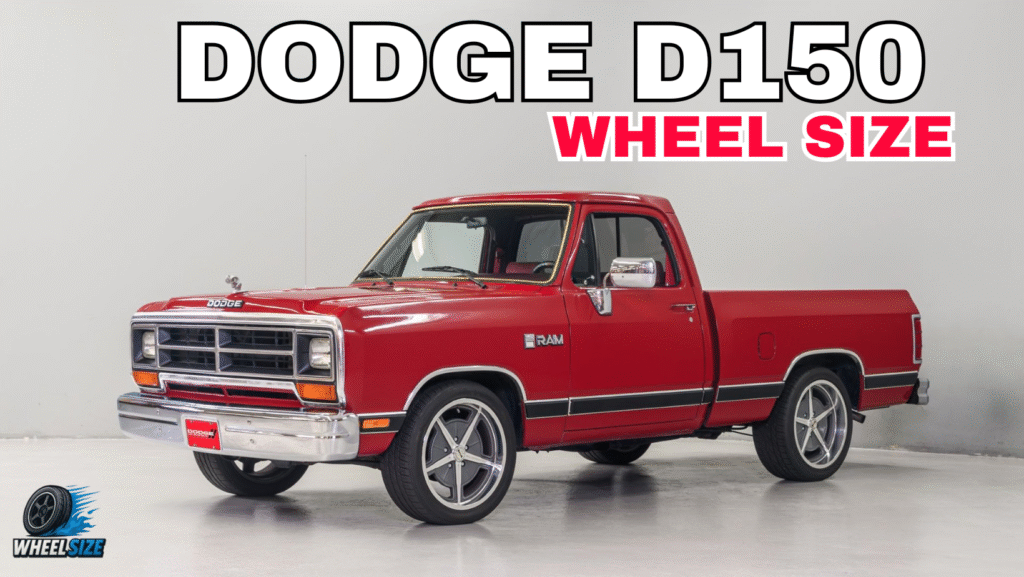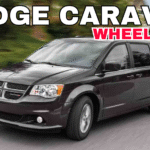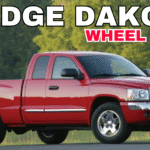The Dodge D150 is one of the most famous pickup trucks made by Dodge. It was made in three different generations from 1961 to 1980. Each time period had its own design ideas, mechanical changes, and wheel specs. For people who love cars and want to restore them, knowing how to fit wheels is important for both getting the right factory look and making sure the car is safe to drive and works well. If you pick the improper wheel size, bolt pattern, or offset, you could have problems with clearance, strain on the suspension, or even unsafe driving conditions. This article tells you how to suit each model of the Dodge D150. It gives you useful information about stock specs, aftermarket enhancements, and useful recommendations for getting the most out of your old pickup truck.
Dodge D150 Wheel Fitment Basics
Before we get into each generation, we need to know what makes a wheel fit properly. The bolt pattern is one of the most important metrics because it tells you if a wheel will fit. The offset and backspacing are also important since they change how the wheel sits in the fender. For a secure fit, the center bore must be the same size as or bigger than the hub. The size of the tires is also quite important because it affects how comfortable the ride is, how well the steering responds, and the overall stance. Many owners of antique Dodge pickups update to larger alloy wheels for style and performance, even though the trucks originally came with steel wheels with lesser diameters. Getting these essentials properly is important for any restoration or upgrade project since it keeps the tires from rubbing, wearing unevenly, or handling poorly.
Dodge D150 AD I (1961–1965) – Wheel Fitment Guide
The first-generation Dodge D150 had a dramatic look that was typical of the early 1960s, and it was built to last. Most of Dodge’s classic trucks had factory wheels that were 15 inches in diameter and had a 5-lug bolt design that stayed the same. It was easy to fit the wheels to the boxy “Sweptline” bed type. Owners should be careful with clearance when upgrading because the suspension geometry was rather rudimentary back then. Wider wheels can improve posture, although really large wheels may rub against things. Some restorers like to stick closely to factory specs to keep everything original, while others add small upgrades to make handling better. Tires with taller sidewalls frequently seem the most like they belong in the time period, combining design and comfort.
Advice for AD I Owners
Owners of AD I models must decide whether to keep things original or add modern embellishments. Collectors want original wheels because they keep their worth, but aftermarket wheels let you make changes. When you upgrade, only make little changes to the size so you don’t put too much stress on the truck’s suspension. When restoring a car, the best thing to do is frequently to find OEM-style steel wheels with the right trim rings.
| Year | Hub Bore (mm) | Bolt Pattern (PCD) | Thread Size | OEM Tire Size | OEM Rim Size | Tire Pressure (F/R, bar) | Aftermarket Wheel Size Range |
|---|---|---|---|---|---|---|---|
| 1961 | 71.6 | 5×114.3 | 1/2″ – 20 UNF | 205/75R15 98Q | 6JJx15 ET20 | 1.8 | 15″ – 16″ |
| 1962 | 71.6 | 5×114.3 | 1/2″ – 20 UNF | 205/75R15 98Q | 6JJx15 ET20 | 1.8 | 15″ – 16″ |
| 1963 | 71.6 | 5×114.3 | 1/2″ – 20 UNF | 205/75R15 98Q | 6JJx15 ET20 | 1.8 | 15″ – 16″ |
| 1964 | 71.6 | 5×114.3 | 1/2″ – 20 UNF | 205/75R15 98Q | 6JJx15 ET20 | 1.8 | 15″ – 16″ |
| 1965 | 71.6 | 5×114.3 | 1/2″ – 20 UNF | 205/75R15 98Q | 6JJx15 ET20 | 1.8 | 15″ – 16″ |
Dodge D150 AD II (1966–1971) – Wheel Fitment Guide
The second model had a more polished exterior and changes to the inside, but how well the wheels fit was still an important part of how useful the vehicle was. Dodge kept using 15-inch wheels, and the bolt patterns and backspacing were the same as they were in the original version. However, improvements to the suspension made it possible to choose from a few additional aftermarket options. A lot of fans update these vehicles with polished alloys or period-correct mag wheels to make them seem better without losing the original look. If you choose the right offset, larger wheels can function without getting in the way of the fender or suspension. During this time, there were more choices for tires, which made it easier for owners to find a balance between looks and performance. For people who are restoring, keeping the standard fitment retains the authenticity, and small changes make it more flexible.
Advice on how to fit AD II models
AD II trucks can profit from small wheel improvements, especially if you drive them every day. Owners can safely put on tires that are a little wider without losing control. Avoid offsets that are too forceful, as they can change the geometry of the steering. A balanced fit makes sure that the ride is comfortable and works well.
| Year | Hub Bore (mm) | Bolt Pattern (PCD) | Thread Size | OEM Tire Size | OEM Rim Size | Tire Pressure (F/R, bar) | Aftermarket Wheel Size Range |
|---|---|---|---|---|---|---|---|
| 1966 | 71.6 | 5×114.3 | 1/2″ – 20 UNF | 205/75R15 98Q | 6JJx15 ET20 | 1.8 | 15″ – 16″ |
| 1967 | 71.6 | 5×114.3 | 1/2″ – 20 UNF | 205/75R15 98Q | 6JJx15 ET20 | 1.8 | 15″ – 16″ |
| 1968 | 71.6 | 5×114.3 | 1/2″ – 20 UNF | 205/75R15 98Q | 6JJx15 ET20 | 1.8 | 15″ – 16″ |
| 1969 | 71.6 | 5×114.3 | 1/2″ – 20 UNF | 205/75R15 98Q | 6JJx15 ET20 | 1.8 | 15″ – 16″ |
| 1970 | 71.6 | 5×114.3 | 1/2″ – 20 UNF | 205/75R15 98Q | 6JJx15 ET20 | 1.8 | 15″ – 16″ |
| 1971 | 71.6 | 5×114.3 | 1/2″ – 20 UNF | 205/75R15 98Q | 6JJx15 ET20 | 1.8 | 15″ – 16″ |
Dodge D150 AD III (1972–1980) – Wheel Fitment Guide
By the third generation, Dodge had made the D150 more modern by giving it smoother body lines and more trim options. The fit of the wheels grew more flexible. Factory 15-inch steel wheels were still normal, but aftermarket options became more widespread. Because the suspension and fender designs were more flexible, many owners tried out bigger wheels. There were also specialist trims like the Adventurer and Warlock at this time. These trims often had improved wheels that went well with the unusual appearance. People who love older models typically choose alloys or chrome wheels for them today. older wheels combine old-school style with modern style. You can make the tires a little bigger, which will make the ride more stable without making it less comfortable. To keep the truck from having clearance problems and to keep it balanced, the right offset is still very important.
AD III Fitment Tips:
If you’re thinking about getting bigger wheels, AD III models are the ideal choice because they have better suspension and more room in the wheel well. Aggressive tires may be employed on off-road builds, whereas street-focused vehicles do well with wider alloys. Always check the offset again to make sure it doesn’t rub.
| Year | Hub Bore | Bolt Pattern | Thread Size | OEM Tire Size | OEM Rim Size | Tire Pressure | Aftermarket Wheel |
|---|---|---|---|---|---|---|---|
| 1972 | 71.6 | 5×114.3 | 1/2″ – 20 UNF | 205/75R15 98Q | 6JJx15 ET20 | 1.8 | 15″ – 17″ |
| 1973 | 71.6 | 5×114.3 | 1/2″ – 20 UNF | 205/75R15 98Q | 6JJx15 ET20 | 1.8 | 15″ – 17″ |
| 1974 | 71.6 | 5×114.3 | 1/2″ – 20 UNF | 205/75R15 98Q | 6JJx15 ET20 | 1.8 | 15″ – 17″ |
| 1975 | 71.6 | 5×114.3 | 1/2″ – 20 UNF | 205/75R15 98Q | 6JJx15 ET20 | 1.8 | 15″ – 17″ |
| 1976 | 71.6 | 5×114.3 | 1/2″ – 20 UNF | 205/75R15 98Q | 6JJx15 ET20 | 1.8 | 15″ – 17″ |
| 1977 | 71.6 | 5×114.3 | 1/2″ – 20 UNF | 205/75R15 98Q | 6JJx15 ET20 | 1.8 | 15″ – 17″ |
| 1978 | 71.6 | 5×114.3 | 1/2″ – 20 UNF | 205/75R15 98Q | 6JJx15 ET20 | 1.8 | 15″ – 17″ |
| 1979 | 71.6 | 5×114.3 | 1/2″ – 20 UNF | 205/75R15 98Q | 6JJx15 ET20 | 1.8 | 15″ – 17″ |
| 1980 | 71.6 | 5×114.3 | 1/2″ – 20 UNF | 205/75R15 98Q | 6JJx15 ET20 | 1.8 | 15″ – 17″ |
Popular Wheel & Tire Upgrades for Dodge D150
One of the most common changes made to all Dodge D150 models is to upgrade the wheels and tires. Classic steel wheels give a car a retro aspect, especially when they include hubcaps or trim rings. Modern alloys, on the other hand, make the wheels stronger and look new. For tires, the right balance between the height of the sidewalls and the width of the tread makes sure they are comfortable and provide good traction. People who like to go off-road frequently choose tough all-terrain tires, whereas people who construct cars for the street like to choose performance rubber. Wider wheels can help with grip, but you need to be careful when measuring to make sure they fit. Owners get the best of both worlds when they mix classic design with modern wheel technology. They get the beauty of a classic car with better safety and performance. Not only do the right enhancements make these historic cars look better, they also make driving them more fun.
Common Fitment Issues & How to Avoid Them
It can be hard to get the right fit for wheels, especially on older cars like the Dodge D150. picking the improper bolt pattern can stop installation, and picking an offset that pulls the wheel too far in or out are two common concerns. This might make the car scrape against parts of the suspension or fenders, which would make driving risky. Another common problem is not paying attention to backspacing, which affects how the wheel sits in relation to the brakes and steering. Always measure carefully and make sure the wheels will fit before you buy them to avoid these complications. You can avoid making expensive mistakes by looking at fitment charts, talking to other owners, and trying out fake setups. If you install it correctly, your classic truck will stay safe, beautiful, and fun to drive.
Conclusion
There are three models of the Dodge D150, and each one has its own set of things to think about when it comes to fitting wheels. Correct fitment makes sure that both safety and style are taken care of, from the simple configurations of the early 1960s to the more versatile options of the late 1970s. Some truck owners may want to stick to factory specs to keep things authentic, while others may want to make small changes to make their trucks more comfortable and unique. Knowing how to read bolt patterns, offset, and tire sizes is important to prevent making frequent mistakes. With the appropriate technique, wheel improvements not only make the Dodge D150 easier to handle, but they also show off how timeless it is, keeping these classic pickups going strong for years to come.



